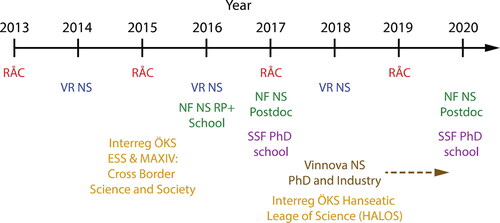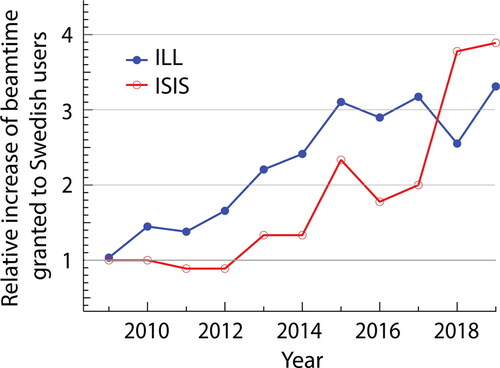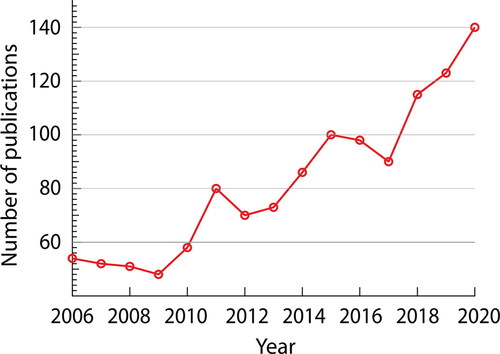1. Introduction
The Swedish Neutron Scattering Society (SNSS) is an organization open to all those associated with Sweden who are using, or interested in the use of, neutron scattering techniques. Currently, the SNSS has around 230 members distributed all over Sweden. The SNSS is a member of the European Neutron Scattering Association (ENSA) [Citation1], which represents the majority of the national neutron scattering societies and committees in Europe.
The overriding objectives of the SNSS are to provide a forum for discussion and exchange of information related to neutron scattering, to stimulate the use of neutron techniques at present-day and future neutron sources, to promote cooperation in neutron science, and to strengthen and broaden the competence in neutron science in Sweden. To meet these objectives, SNSS is engaged in and takes the lead in a variety of different activities. Examples of such are the organization of conferences, workshops, schools and other educational activities related to neutron scattering. Additionally, SNSS represents Swedish neutron scatterers in strategic discussions with funding agencies, universities, scattering communities, and neutron facilities. In 2015, SNSS developed a Swedish Strategy for science using neutrons [Citation2]. This is regularly reviewed and updated, and supports in, e.g., decision making processes related to research and education using neutron scattering techniques at universities, industries, funding agencies, and other stakeholders. Furthermore, SNSS hosts a web page with relevant information for and about the Swedish and international neutron scattering community, including monthly research highlights [Citation3]. SNSS also distributes an electronic Monthly Newsletter to all members and posts with news on Twitter.
To analyze the current scientific activities where neutron scattering is used involving scientists with a Swedish affiliation and to meet the above mentioned objectives, the SNSS Board has carried out a bibliometric survey, which is presented in this document.
2. User groups
This study is based on the bibliometric survey of the Nordic and Baltic regions published recently [Citation4] and complemented by our own bibliographic search using the same search protocol in ISI Web of Science using the following keywords: (TS =(neutron* OR “SANS” OR “structure factor” OR “spin wave”) AND AD = Sweden). The neutron-based techniques are specifically given in the keywords or elsewhere in the article text. The entries were verified manually to eliminate false positives, but no active searching was done to eliminate bias or identify false negative results. The only exception is the Journal of Neutron Research, which was searched manually, since this journal did not appear in ISI Web of Science until recently.
Most universities in Sweden have groups that exploit neutron techniques for their research activities, with a focus on chemistry, physics, materials science, biology and biomedicine. shows the number of scientific articles published by authors in Sweden in the period from 2006 to 2020, where neutron scattering experiments contributed.
The number of publications remained fairly constant until 2010. Around this time the decision to build the European Spallation Source (ESS) close to Lund was made. Since then, a clear increase in the number of publications per year for scientists with a Swedish affiliation is observed. In all likelihood, this increase is an effect of several targeted funding opportunities that were created to strengthen the Swedish neutron community. A schematic of these new initiatives, starting from 2013, is shown in .
Figure 2. Schematics of the funding targeted to neutron scattering (NS) since 2013. RÅC = Röntgen-Ångström Cluster; VR NS = Swedish Research Council Project Grant with focus on neutron scattering; NF NS RP + school = NordForsk 5-year capacity building project and research school within the Nordic Neutron Science Program; NF NS postdoc = NordForsk postdoctoral fellowship with focus on neutron scattering; SSF PhD school = Swedish Foundation for Strategic Research Graduate School in Neutron Science; Vinnova NS PhD and Industry = Vinnova funded projects “Increasing capacity and skills of PhD students regarding industrially relevant neutron and synchrotron based analytical methods” and “Industrial utilization of neutron and synchrotron light based technologies in large-scale research infrastructure.”

Expert, frequent, and infrequent users
To evaluate the Swedish user community in more detail, shows the Swedish neutron users categorized with respect to the number of publications over the 5-year time periods 2006–2010, 2011–2015 and 2016–2020. The data are further divided into expert users, frequent users, and infrequent users. Expert users are defined as those scientists publishing at least 10 papers in a 5-year period, and these are, typically, permanent staff at universities, and postdocs using neutron methods as one of their standard research tools, and/or people involved in the development of new methodology and/or instrumentation. Frequent users are defined as scientists that publish four to nine papers over a 5-year period. Infrequent users publish two to four papers over a 5-year period. The latter include scientists new to the field, as well as PhD students. Note, authors having published just one paper are not counted in our survey.
Table 1. Number of Swedish neutron users over the 5-year time periods 2006–2010, 2011–2015 and 2016–2020, by publication frequency.
The total number of expert users grew from 14 (2006–2010 period), to 19 (2011–2015 period), and to 21 (2016–2020 period), that is by 50% over the whole period, if ESS affiliated scientists are included. However, without ESS affiliated scientists, the expert user group has actually decreased in Sweden by roughly 30% from 2006–2010 to 2016–2020. The frequent and infrequent users on the other hand show a very strong growth, of approximately 220% (frequent users) and 240% (infrequent users), over the whole time period, with ESS scientists excluded. An even stronger growth is found with ESS scientists included. The total number of Swedish based authors over the whole time period studied is 1109. The total number of authors with two or more publications is 609.
On the basis of our analysis, it can be stated that the targeted funding clearly results in a larger and more diverse user community and seems well suited to prepare the Swedish user community for the ESS. It is therefore desirable to continue the current funding schemes or even complement them with new programs to further strengthen and consolidate existing activities. However, it is also obvious that the funding schemes have not succeeded at retaining or attracting expert users. In effect, this shows that efforts to keep and promote expert users in Sweden as well as to attract new international experts are urgently needed.
3. Neutron techniques
shows the publications divided among neutron scattering techniques. The division is based upon instrument classes, real and reciprocal space machines, low and high momentum transfer (Q), as well as elastic and inelastic scattering techniques. Some instruments, e.g., triple axis machines, may, however, be represented as inelastic or high resolution diffraction. Publications reporting data from different classes of instruments were categorized with respect to the dominating technique. Data is given for the time period from 2006 to 2020.
Table 2. Number of publications divided with respect to neutron scattering technique over the time periods 2006–2010, 2011–2015 and 2016–2020 [Citation4].
Traditionally, Sweden is strong in diffraction, which is related to the operation of the Studsvik reactor as well as national initiatives as the Polaris diffractometer at ISIS. Even though the Studsvik reactor was shut down in 2006, diffraction is still the dominating method used but with no growth during the time period evaluated here. Other methods that have historically fewer publications, however, show a clear and strong growth. The most significant in this context is the use of low Q methods such as reflectometry (306% growth over 10 years) and SANS (283% growth over 10 years). Both instrument classes now have a usage which is similar to that of diffraction. The strong growth in reflectometry has benefitted from the national infrastructure SuperADAM, located at ILL, which is currently the only Swedish operated neutron instrument. A similar growth as for the low Q methods is observed for inelastic scattering (355% growth over 10 years), but the total number of publications is still slightly lower as compared to low Q or diffraction.
Imaging (which was not used by the Swedish community before 2013) has now an increasing number of publications and instrumentation had a significant growth during the period 2010–2015, but lately remained constant. This might be related to the increasing number of ESS staff which strongly grew during the years 2010 to 2015 as well as national initiatives, such as Polaris and SuperAdam, which started around this time, see . From the analysis it seems that the current neutron access schemes available to Swedish based users adequately compensate for the loss of the Studsvik reactor as national facility, however, with a risk of a missing national center coordinating neutron related activities. The use of other techniques (as defined in the caption of ) remained roughly constant during the last 15 years.
The analysis underlines the success of the funding mechanisms. Moreover, it is motivating that the Swedish neutron scattering community has expanded and is now using all available tools, with strong growth rates on the previously underrepresented areas. This will allow the Swedish community to provide valuable input for strategic decisions regarding instrument selection and design, at ESS and other neutron sources.
4. Neutron sources
The Institut Laue-Langevin (ILL) in Grenoble (France) operates the most powerful neutron source for research in the world and is the leading center of neutron scattering in Europe. Beam time is allocated among researchers from the member countries in a competitive proposal evaluation. Sweden became a member of the ILL in 2005. Ever since, the use of ILL beamtime by Swedish scientists shows a strong increase over the last 15 years by approximately 300%. Sweden contributes to the budget of the ILL as well as through the operation of the neutron reflectometer SuperADAM. In 2019, Swedish users represented 4.8% (plus the internal Swedish time on SuperADAM) of the use of ILL [Citation5].
gives the number of publications per neutron facility during the time periods 2006–2010, 2011–2015 and 2016–2020. In total, over the past 5 years, about 150 papers were published by Swedish users from ILL experiments, which is the highest number among the facilities. The second most used source amongst Swedish researchers is the ISIS Neutron and Muon Source in the U.K., with a growth in use of beamtime very similar to the ILL [Citation6]. The other sources are used to a smaller extent.
Table 3. Publications at neutron sources, over the time periods 2006–2010, 2011–2015 and 2016–2020.
The beamtime usage at the ILL and ISIS over the past years is shown in . There has been a steady increase in the beamtime allocated at these facilities. This growth is very similar to that in the number of publications () and suggests that the beamtime allocated directly correlates to the output in publications by Swedish researchers. To further consolidate and broaden the user community, Sweden needs to keep securing beamtime at neutron facilities, in open beam time application calls as well as targeted and direct access schemes such as the one for SuperADAM.
Figure 3. Relative increase in beamtime usage at ILL (blue) and ISIS (red) during the time period 2009–2019.

Over the past 5 years almost 75% of all published papers resulted from work performed at either ILL or ISIS. These two facilities are crucial for the neutron scattering activities in Sweden and it will be interesting to see how ESS will impact this picture over the years to come. Given this fact it seems important for Swedish researchers to take an active role on the strategic decisions concerning these two facilities as well as ESS.
Apart from ILL and ISIS, Swedish users exploit other European neutron facilities, such as Studsvik in Nyköping (shut down in 2005), Sweden, the Helmholz Zentrum Berlin (HZB) in Berlin (shut down in 2019), Germany, the Paul Scherrer Institute (PSI) in Villigen, Switzerland and the FRM II facility in Garching, Germany, as well as non-European neutron facilities, i.e., Australian Nuclear Science and Technology Organization (ANSTO) in Sydney, Australia, the NIST Center for Neutron Research (NCNR) in Gaithersburg, U.S., and the Spallation Neutron Source (SNS) in Oak Ridge, U.S. It is remarkable that ANSTO is used relatively frequently by Swedish users. This might be related to auxiliary facilities/capabilities, like, e.g., the deuteration lab, at ANSTO and demonstrates the importance of access to such infrastructure. Although Studsvik was decommissioned in 2006, i.e., before the period of the current bibliometric survey, the number of articles published were still high with the latest article being published as late as in 2011.
As a model for the time scales for the ramp up of new facilities SNS may be considered, which started its user phase in the summer of 2007, with initially three instruments. It took about 10 years to reach a distinct increase in number of publications. A similar development can be expected for ESS producing first neutrons around 2023 with a limited number of instruments operating in the first years. It is absolutely crucial for the Swedish neutron scattering community to keep up the use of other existing facilities and national initiatives to bridge the time until ESS reaches its full capabilities, which may not be until 2035.
5. Scientific topics
shows the number of publications divided into different scientific topics, as defined by the ILL “colleges.” The categorizing is performed by our own judgement after browsing each article. Note, the ILL college 6 “glass and liquid dynamics” has been merged with college 7 “materials dynamics,” whereas college 1 has been split into two topics, “engineering/geology” and “instrumentation,” respectively. College 3 “nuclear physics” has not been included in this analysis.
Table 4. Number of publications as divided into scientific topics, over the time periods 2006–2010, 2011–2015 and 2016–2020 [Citation4].
As can be seen, Swedish researchers are primarily active in hard and soft matter structure, which constitute 40% of the total number of publications. All scientific topics have an increasing number of publications over the last 15 years. The largest growth includes the topics of instrumentation and archeology/geology since they were almost non-existing in the 2006–2010 time period, as well as in biology and health with a 400% increase since 2006. Engineering, soft matter and dynamics show a similar growth (150–180%) while hard matter structure remained roughly constant. There is a considerable broadening of the Swedish user base towards areas such as soft matter, biology/health, instrumentation and engineering.
6. Conclusions & outlook
The Swedish neutron scattering community counts about 230 scientists as of the first quarter of 2021, who have in total published 1194 neutron-related articles over the period 2006–2020. During this time the publication rate has been clearly and strongly increasing. This is related to the increase in research funding available in Sweden, especially since 2013. It is particularly positive that the Swedish user community has expanded and nowadays uses all of the neutron techniques available and covers a wide range of scientific topics. However, it is concerning that the number of expert users (groups with a strong focus on neutron science) has decreased in the same period of time. The funding initiatives provided in the country have succeeded in growing and broadening the user base in Sweden but were unable to establish and attract new expert users. New funding initiatives and targeted strategies are therefore urgently needed to ensure that the broadened user community can be consolidated and will not be lost to other geographical regions. This is particularly important if the Swedish research community shall be able to take advantage of the ESS once it is fully up and running. Furthermore, in order to keep the user base, it is essential to maintain the commitment to other facilities as well as the ESS.
Correction Statement
This article has been corrected with minor changes. These changes do not impact the academic content of the article.
References
- Technical University Delft, European Neutron Scattering Associated, https://ensa.tudelft.nl (accessed 9 Nov. 2021).
- Swedish Neutron Scattering Society, Neutrons - A Swedish Strategy for 2015 to 2025 and Beyond, http://snss.se/wp-content/docs/Neutron_Strategy_2015_final_Eng.pdf (accessed 9 Nov. 2021).
- Swedish Neutron Scattering Society, SNSS, http://www.snss.se (accessed 9 Nov. 2021).
- T. Thornsen Røhling and K. Lefmann, Nordic and Baltic Neutron Scattering Communities 2006–2019—A Bibliometric Study, 2020.
- Institut Laue-Langevin, ILL, https://www.ill.eu (accessed 9 Nov. 2021).
- Science and Technology Facilities Council, ISIS Neutron and Muon Source, https://www.isis.stfc.ac.uk (accessed 9 Nov. 2021).

